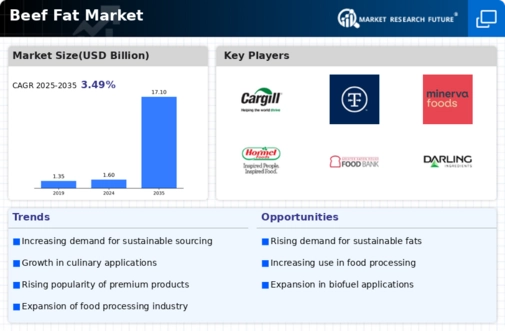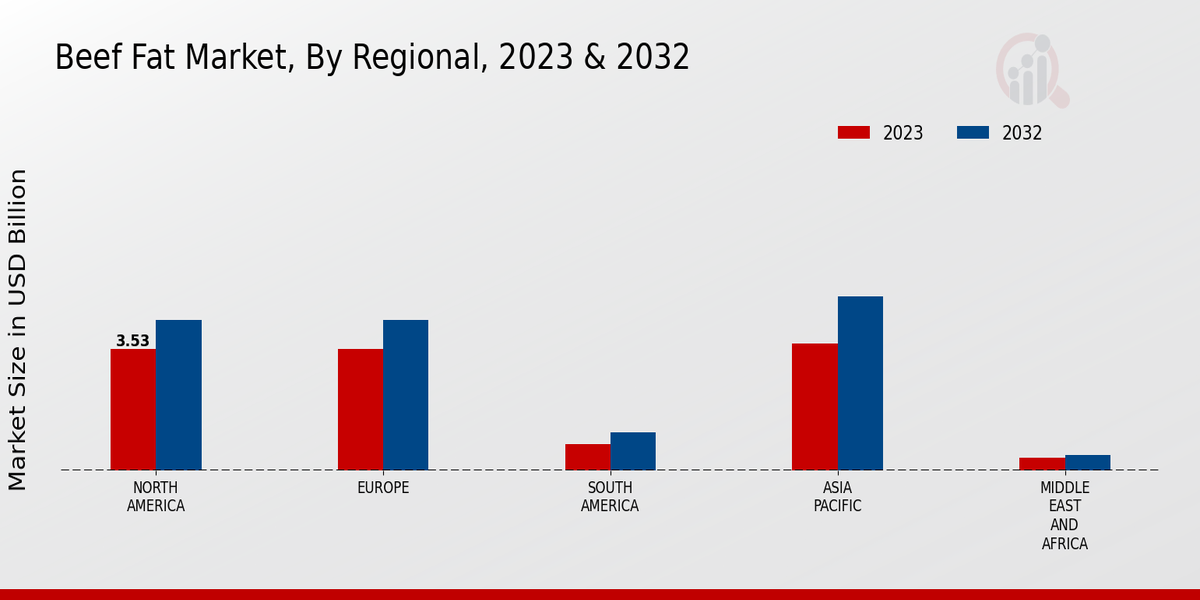Market Growth Projections
The Global Beef Fat Market Industry is poised for substantial growth, with projections indicating a compound annual growth rate (CAGR) of 24.01% from 2025 to 2035. This growth trajectory suggests a robust demand for beef fat across various applications, including culinary and industrial uses. The anticipated increase in market size from 1.6 USD Billion in 2024 to 17.1 USD Billion by 2035 reflects the evolving consumer preferences and the expanding food processing sector. Such projections underscore the potential for innovation and investment within the beef fat market.
Health and Nutritional Awareness
In recent years, there has been a shift in consumer attitudes towards dietary fats, with an increasing recognition of the nutritional benefits of beef fat. The Global Beef Fat Market Industry benefits from this trend, as beef fat is rich in essential fatty acids and vitamins. This awareness is driving demand among health-conscious consumers who seek to incorporate healthy fats into their diets. Furthermore, as the market evolves, educational initiatives promoting the health benefits of beef fat are likely to enhance its acceptance, potentially contributing to the market's growth trajectory.
Expansion of Food Processing Sector
The Global Beef Fat Market Industry is significantly influenced by the expansion of the food processing sector. As food manufacturers seek to enhance flavor profiles and improve product texture, beef fat serves as a valuable ingredient. The increasing production of processed foods, including snacks and ready-to-eat meals, is likely to elevate the demand for beef fat. This trend aligns with the projected market growth, which is expected to reach 17.1 USD Billion by 2035, indicating a robust opportunity for beef fat suppliers in the evolving food landscape.
Sustainability and Ethical Sourcing
Sustainability concerns are becoming paramount in the food industry, influencing consumer choices and production practices. The Global Beef Fat Market Industry is not exempt from this trend, as consumers increasingly demand ethically sourced and sustainably produced ingredients. This shift is prompting beef fat producers to adopt more sustainable practices, such as responsible sourcing and waste reduction. As consumers prioritize sustainability in their purchasing decisions, the market for beef fat may see a positive impact, aligning with broader trends in the food industry.
Rising Demand for Natural Ingredients
The Global Beef Fat Market Industry experiences a notable surge in demand for natural and minimally processed ingredients. Consumers increasingly prefer products that are perceived as wholesome and authentic, leading to a heightened interest in beef fat as a natural flavor enhancer and cooking fat. This trend is particularly evident in the food service sector, where chefs seek to incorporate traditional ingredients into modern cuisine. As a result, the market is projected to reach 1.6 USD Billion in 2024, reflecting a growing consumer inclination towards natural food products.
Culinary Trends Favoring Traditional Fats
Culinary trends are increasingly favoring traditional fats, including beef fat, as chefs and home cooks alike embrace authentic cooking methods. The Global Beef Fat Market Industry stands to benefit from this resurgence, as beef fat is recognized for its ability to impart rich flavors and enhance the overall culinary experience. This trend is evident in various cuisines worldwide, where beef fat is utilized in traditional dishes. As culinary enthusiasts seek to recreate authentic flavors, the demand for beef fat is likely to rise, further solidifying its position in the market.




















